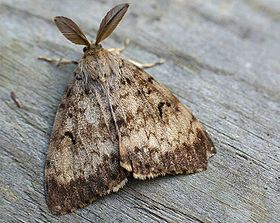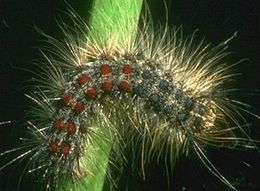- Lymantria dispar
-
Polilla gitana

macho adultoClasificación científica Reino: Animalia Filo: Arthropoda Clase: Insecta Orden: Lepidoptera Familia: Lymantriidae Género: Lymantria Especie: L. dispar Nombre binomial Lymantria dispar
Linnaeus, 1758Sinonimia - Phalaena dispar Linnaeus, 1758
- Ocneria dispar Linnaeus, 1758
- Porthetria dispar Linnaeus, 1758
Lymantria dispar Linnaeus, es un lepidóptero de la familia Lymantriidae, de origen eurasico. Originalmente hallada de Europa a Asia, siendo introducida a Norteamérica a fines de 1860s, ampliando su rango. También se la conoce como polilla gitana asiática.
En su estado de imago tiene un marcado diformismo sexual, la hembra tiene alas características de color blanco; además, es muy torpe siendo incapaz de volar. Su ciclo completo dura un año.
Las mariposas se aparean en julio, colocando la puesta en forma de característicos plastones de color amarillo. Los huevos son muy resistentes al frío. Ya en primavera eclosionan los huevos, y nacen las orugas, que sufriran cuatro o cinco mudas hasta pasar a la fase de imago. Se trata de un defoliador, que en España ataca principalmente al género Quercus, aunque puede atacar otras frondosas.
Referencias
- Barbosa, P. & Greenblatt, J. 1979. Suitability, digestibility and assimilation of various host plants of the gypsy moth Lymantria dispar L. (Lepidoptera, Lymantriidae). Oecologia 43(1): 111-119
- Barbosa, P.; Waldvogel, M.; Martinat, P. et al. 1983. Developmental and reproductive performance of the gypsy moth, Lymantria dispar (Linnaeus) (Lepidoptera, Lymantriidae), on selected hosts common to mid-atlantic and southern forests. Environmental Entomology 12(6): 1858-1862
- Dwyer, G. & Elkinton, J.S. 1993. Using simple-models to predict virus epizootics in gypsy-moth populations. Journal of Animal Ecology 62(1): 1-11
- Elkinton, J.S.; Healy, W.M.; Buonaccorsi, J.P.; Boettner, G.H.; Hazzard, A.M.; Smith, H.R. & Liebhold, A.M. 1996. Interactions among gypsy moths, white-footed mice, and acorns. Ecology 77(8): 2332-2342
- Fullard, James H. & Napoleone, Nadia. 2001. Diel flight periodicity and the evolution of auditory defences in the Macrolepidoptera. Animal Behaviour 62(2): 349–368. doi 10.1006/anbe.2001.1753 PDF completo
- Gansner, D.A.; Herrick, O.W.; Mason, G.N. & Gottschalk, K.W. 1987. Coping with the gypsy moth on new frontiers of infestation. Southern Journal of Applied Forestry Research 11: 201-209
- Gould, J.R.; Elkinton, J.S. & Wallner, W.E. 1990. Density-dependent suppression of experimentally created gypsy moth, Lymantria dispar (Lepidoptera, Lymantriidae), populations by natural enemies. Journal of Animal Ecology 59(1): 213-233
- Porter, Jim. 1997. The Colour Identification Guide to Caterpillars of the British Isles (Macrolepidoptera). Viking, London. pp. 81
- Rossiter, M.C. 1991. Maternal effects generate variation in life-history - consequences of egg weight plasticity in the gypsy moth. Functional Ecology 5(3): 386-393
- Waring, P., Townsend, M. and Lewington, R. 2003. Field Guide to the Moths of Great Britain and Ireland. British Wildlife Publishing, Hook, UK. pp. 211
- Weseloh, R.M. & Andreadis, T.G. 1992. Epizootiology of the fungus Entomophaga maimaiga, and its impact on gypsy moth populations. Journal of Invertebrate Pathology 59(2): 133-141
Enlaces externos
 Wikimedia Commons alberga contenido multimedia sobre Lymantria disparCommons.
Wikimedia Commons alberga contenido multimedia sobre Lymantria disparCommons.- asiangypsymoth.org
- Polilla gitana en Marruecos
- Acerca de Entomophaga maimaiga
- Species Profile- European Gypsy Moth (Lymantria dispar), National Invasive Species Information Center, United States National Agricultural Library. Listas generales informativas y recursos de la polilla gitana europea
Wikimedia foundation. 2010.

